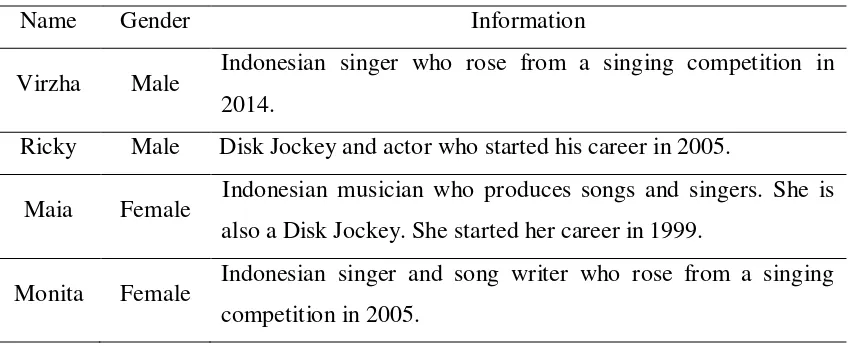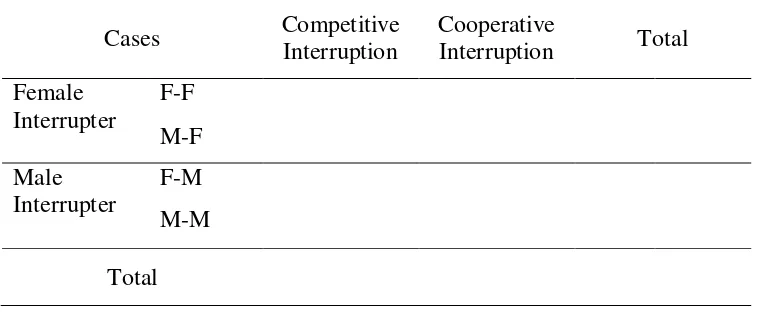CHAPTER III
RESEARCH METHODOLOGY
This chapter describes research methodology used in the research. First, it describes the research
design used in the research. Second, it describes the data collection that shows the participants of
the conversation in the data. Third, it describes data analysis that includes the steps to analyze the
data.
3.1 Research Design
This research mainly used qualitative method in collecting and analyzing the data. According to
Creswell (2012), qualitative method aims to explore problems to obtain a deep understanding of
a phenomenon. A qualitative method does not use statistic to analyze the data, instead it uses
words or photos. Furthermore, according to Creswell (2012, p. 19), “Qualitative research
analyzed the words to group them into larger meanings of understanding, such as codes,
categories, or theme.” This research used a qualitative method because this research analyzed words and categorized them in order to answer the research questions. This research analyzed the
interruption used by the male and female speakers in a mixed-gender conversation as the central
phenomenon. Moreover, the previous studies by Faizah (2015) and Fei (2010) also used a
qualitative approach to analyze the data. However, a simple quantitative measure in the form of
categorical measurement is also used to count the frequency of occurrence of particular data.
3.2 Data Collection
The data of this research were taken from an Indonesian talk show entitled Ini Talk Show. Talk
show is chosen because talk shows can be regarded as a particular kind of face-to-face
conversation (Illie, 2001). Moreover, talk shows are considered as semi-institutional
conversation because talk show has both the characteristics of institutional and everyday
conversations. In talk shows, even if the host can control the conversation by asking questions,
the guests have the right to ask or comment something (Illie, 2001). The data of this paper were
IniTalk Show is an Indonesian talk show that is aired every Monday to Friday at 8 P.M. The
setting of conversation in IniTalk Show is the host, co-hosts, and guests are gathered. The host
and co-host can ask something to the guests and the guests can talk freely.The reason why the
data were taken from Ini Talk Show is because the researcher wants to know how male and
female speakers interrupt the conversation in an interview setting. Ini Talk Show is different from
other talk shows because it contains comedic elements from the host and co-hosts; thus, the
conversation runs naturally. “Comedic talk shows allowed the interviewee to ask questions while
in formal talk shows the interviewee is not encouraged to ask questions” ( Danileiko, 2005, p.
13). Comedic talk shows do not always follow the rules and norm of conversation, instead
comedic talk shows tend to break the rules to make the conversation more comedic. IniTalk
Show is called comedic talk show because it contains many comedy scenes and the host and
co-hosts are comedian.
The guests were involved as the subject of this study. They are two males: Virzha and Ricky and
two females: Maia and Monita.
Table 3.1 Information about the Guests in the Data
Name Gender Information
Virzha Male Indonesian singer who rose from a singing competition in 2014.
Ricky Male n Disk Jockey and actor who started his career in 2005.
Maia Female Indonesian musician who produces songs and singers. She is also a Disk Jockey. She started her career in 1999.
Monita Female Indonesian singer and song writer who rose from a singing competition in 2005.
The full video in this talk show was divided into six parts. Part one (28 minutes long) is
consisted of the opening from the host and co-host and the invitation of two guests by them. Part
two (13 minutes long)is consisted of the invitation of another guest and guest performance. Part
three (14 minutes long)is consisted of the invitation of another guest. Part four (15 minutes
long)is consisted of games and the invitation of the guest’s friend. Part six (nine minutes long) is
consisted of the closing. In this research, only the conversations from part three were analyzed.
The reasons for using the third part are: first, in analyzing how the speakers interrupt in a
mixed-gender conversation, it requires male and female speakers in equal numbers. In the particular part
analyzed, there are four guests: Maia, Monita, Ricky, and Virzha. Second, since the analysis
requires a natural conversation, the host and co-hosts were excluded in the analysis. It is because
basically, the host has the right to control the conversation, and thus it will make the host
dominates the conversation. Besides, the distractions from co-host are not natural since they are
controlled by the script. The distractions from co-hosts are not as many as in other parts. In this
part, unlike in other parts the co-host do not dominate the conversation, hence the third part is the
most appropriate one to be used for analysis.
For further analysis, the video was transcribed following the Jefferson’s transcription (as
cited in Paltridge, 2006). In transcribing the conversation, it was not only the words that were
being transcribed but also the non-lexical and non-verbal items such as breathing, laughing and
yelling. Breathing is when the speaker takes a deep breath and it is very apparent. Laughing is
when the speaker makes sound like “ha-ha” to indicate that something is funny; any type of laughing is not differentiated in this analysis. Yelling is when the speaker raises his or her voice.
The symbol for interruption is “|” while symbol “—“is used to identify the unfinished sentence.
To find out which gender interrupt the most in the conversation, the turn taking should also be
analyzed. After that, the result can be concluded. The example of transcription of the data was
presented below.
Maia: =Ya,kayakhousenya house of full. Ada yang edm (.) ada yang
elektroada yang macem-macem=
(=Like the house of full. There is edm music (.) electro and many
more=)
Ricky : =Kalausekarangbanyaksihkalausekarangada yang kayakk
(=The genres are more various nowadays. like twerk
(.) melbourne--)
Maia: tuhanakbarunih. Istilahnyaudahgangerti
gua.
(I do not even know the terms anymore.)
Sule: Apalagisaya.
(More so with me.)
(00:03:05)
3.3 Data Analysis
There were several steps taken in the data analysis. Firstly, to answer the first and second
research questions, the types and functions of interruptions occurring in the data were examined.
The types of interruption were analyzed following Ferguson’s theory (1977). The types of
interruption were based on gender perspective. When female speaker was interrupted by male
speaker, it was represented by F-M. Meanwhile, when male speaker was interrupted by female
speaker, it was represented by M-F. Moreover, when male speaker was interrupted by male
speaker, it was represented by M-M. Finally, when female speaker was interrupted by female
speaker, it was represented by F-F. The types of interruptions that occurred in the data are
presented in the table below.
Table 3.2 The Occurrences of Types of Interruption in the Conversation
Types of Interruptions
Cases
Frequency Percentage F Interrupter M Interrupter
F-F M-F F-M M-M
Butting-in
and the implication can be made.
Besides the types, the functions of interruption were also examined following French and
Local (1983). The functions of interruption were divided into two: competitive and cooperative.
The data was in the form of the table that showed the frequency of competitive and cooperative
interruptions that were used by the male and female speakers. The functions of interruption that
occurred in the data are presented in the table below.
Table 3.3 The Occurrences of Functions of Interruption in the Conversation
Cases Competitive
strategies were analyzed. Politeness strategies thatwere used in this research following the theory
from Brown and Levinson (1987). Politeness strategies were analyzed in order to know how the
male and female speakers avoid threatening the current speaker’s face. The politeness strategies
Table 3.4The Occurrences of Politeness Strategies in the Mixed-gender Conversation
No. Positive Politeness Strategies Male Female Total Percentage
Seek agreement
Use in-group identity marker
Notice, attend to hearer
Joke
Presuppose/raise/assert
common ground
Exaggerate
Avoid disagreement
Total
Table 3.5 The Occurrences of Negative Politeness Strategy in the Mixed-gender
Conversation
No. Negative Politeness Strategy Male Female Total Percentage
Don’t presume/assume
Total
After the frequency of politeness strategies that were used by the male and female
speakers were counted, the implication can be made.
Lastly, to answer the fourth research question, the possible factors of the interruption
made by the speaker was explained. The reasons were based on Wardhaugh (as cited in Prasetyo,
2015) that proposed possible factors that make the speakers interrupt. The possible factors that
affect the male and female speakers to interrupt are presented in the table below.
Table 3.6 Factors that Affect Speaker to Interrupt
No. Factors Male Female Total Percentage
Disagreeing
Seeking for clarification
Completing
Correcting
Agreeing
Total
3.4 Concluding Remark
This chapter has explained the methodology of the research. The overview methodology, data
sources, data collections and data analysis to answer the research questions were provided in this

